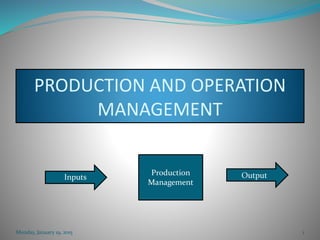PRODUCTION AND OPERATION MANAGEMENT
- 1. PRODUCTION AND OPERATION MANAGEMENT Inputs Production Management Output Monday, January 19, 2015 1
- 2. Integrated Production Management The set of interrelated management activities, which are involves in manufacturing certain products, is called as production management. Procuring the materials. Moving the material for transformation. Training and deploying the force. Implementing the procedures for systematic loading of machines. Maintaining the inventories. Maintaining the machines. Establishing the methods of inspection to ensure the quality. Packaging the products for safe distribution and dispatch. Monday, January 19, 2015 2
- 3. Production Management and Production Control Production management starts with aggregate planning. In aggregate planning all inputs are required to meet the targets, such as raw materials, no. of machines, work force, storage capacity and policy options like sub contracting, overtime, hiring and laying off workers. Make or Buy Decisions Matching Demand Level Capacity In matching method, the production capacity is adjusted to match the forecast demand by varying the level of the workforce by hiring or laying off. In the level capacity method, the production capacity is held constant at an optimum level.The varying demands are met by maintaining the inventory, backlog, overtime or subcontracting Monday, January 19, 2015 3
- 4. Production Management and Production Control The functions of production planning are broadly classified into three: Estimating • Estimating involves identifying the manpower requirements, machine capacity , and materials required to meet the planned targets. Routing • Routing is the process of determining the sequence of operations. Scheduling • Scheduling fixes the priorities for various job and is mainly concerned with the completion of the job at pre-set times. Monday, January 19, 2015 4
- 5. Production Management and Production Control The functions of production control are dispatching and expediting Production Control Dispatching Expediting Dispatching is concerned with setting production activities in motion. The production activities include issuing material, release orders, and moving materials from work centre to work centre. Expediting function ensures that the progress is satisfactory and the path of the production process is cleared of constraints and the workflow is smooth. Monday, January 19, 2015 5
- 6. CapitalProductivity Capital deployed in plant, machinery, buildings and the distribution systems as well as working capital are the components of the cost of manufacturing. Demand fluctuations, uncertainties of production owing to breakdown and inventories being created drag the productivity down. The strategies included are: Outsourcing Strategies – Lack of expertise, Quality considerations, Nature of demand, Cost. Quality Circles - Kaoru Ishikawa is the originator of fishbone diagrams to identify the root causes of any problem. Methods Improvement - This process is to find out how the job is done & breaking it down to the elemental task so that they are amenable for analysis. Balancing of Workstations Rationalization of Packaging Methods Monday, January 19, 2015 6
- 7. Capital Productivity Quality Circle Tools –Kaoru Ishikawa mentioned that the bulk of the quality related problems can be solved by using seven quality control tools, which include Flow Charts - Pareto Diagrams Cause and effect Diagrams Control Charts Scatter Diagram Check Sheet Histogram Monday, January 19, 2015 7
- 8. Capital Productivity Quality Circle Tools – Ishikawa diagram also called fishbone diagram, Cause & effect diagram, used for product design and quality defect prevention, to identify potential factor causing an overall effect. ssssss EFFECT (6Manufacturing Industry) Measurements Materials Environment Methods Machines Monday, January 19, 2015 8 Personnel Data generated from the process that are used to evaluate its quality. Raw materials, parts, pens, paper, etc. used to produce the final product The conditions, such as location, time, temp., and culture in which the process operates Anyone involved with the process Any equipment, computers, tools, etc. required to accomplish the job How the process is performed and the specific requirements for doing it, such as policies, procedures, rules, regulations and laws Inspection Raw Materials Manpower TechnologyNature Process
Editor's Notes
- Planning, both long and short term, requires information about the production capacities of different facilities.
- Original 6Ms used by Toyota Production System referred to as 8Ms, included Management/Money Power, Maintenance.







